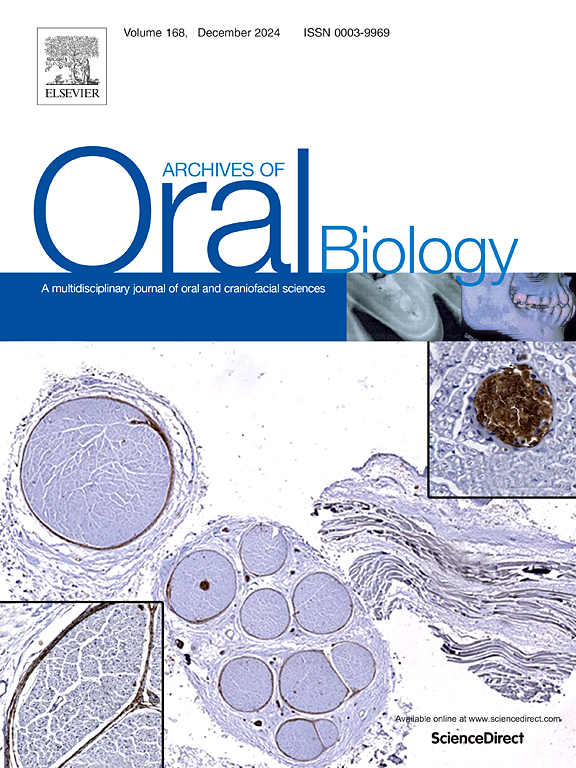Changes in the caries-associated microbiota and caries experience in children and adolescents with type 1 diabetes: A systematic review and meta-analysis
IF 2.2
4区 医学
Q2 DENTISTRY, ORAL SURGERY & MEDICINE
引用次数: 0
Abstract
Objective
This systematic review aimed to determine the differences in the caries-associated microbiota and caries experience among children with type 1 diabetes (T1D) compared to healthy children in observational studies.
Design
Registered in PROPSERO (CRD42024529842), this review involved searching four electronic databases (PubMed, Embase, Scopus and Web of Science) from inception to April 2024. Citation searching was further performed on eligible studies from the database search. Observational studies comparing the cariogenic taxa between paediatric participants (0–18 years of age) with T1D and healthy paediatric participants were included. Caries experience was analysed where available in eligible studies. Outcomes were narratively and tabularly synthesised, and meta-analysis performed where appropriate. All studies were critically appraised using the relevant Joanna Briggs Institute appraisal tool.
Results
425 studies were identified, of which 14 studies were eligible. After assessing 534 citations, 2 additional studies were included. Overall, 16 studies (15 cross-sectional, 1 longitudinal) satisfied the inclusion criteria. Differences in cariogenic bacteria were observed when glycaemic control was considered. Children with T1D and poorer glycaemic control exhibited an increase in Streptococci and Lactobacilli taxa compared to those with improved glycaemic control and healthy children. A small number of studies also found increases in the caries experience with poorer glycaemic control.
Conclusion
Overall, the evidence indicates that children with T1D who have poorer glycaemic control exhibit an increase in cariogenic bacteria. Early evidence suggests that these children also experience more caries. However, further research with improved and longitudinal study designs are required to strengthen the existing evidence.
1型糖尿病儿童和青少年龋齿相关菌群和龋齿经历的变化:一项系统综述和荟萃分析
目的:本系统综述旨在确定观察性研究中1型糖尿病(T1D)儿童与健康儿童在龋齿相关微生物群和龋齿经历方面的差异。设计:在PROPSERO注册(CRD42024529842),本综述检索了四个电子数据库(PubMed, Embase, Scopus和Web of Science),从成立到2024年4月。进一步对数据库中符合条件的研究进行引文检索。观察性研究比较了患有T1D的儿童参与者(0-18岁)和健康儿童参与者之间的龋齿分类群。在符合条件的研究中分析了龋齿经验。对结果进行叙述和表格综合,并在适当的地方进行荟萃分析。所有研究都使用相关的乔安娜布里格斯研究所评估工具进行了批判性评估。结果:共纳入425项研究,其中14项研究符合条件。在评估了534次引用后,纳入了另外2项研究。总的来说,16项研究(15项横断面研究,1项纵向研究)符合纳入标准。当考虑血糖控制时,观察到致龋细菌的差异。与血糖控制良好的儿童和健康儿童相比,糖尿病和血糖控制较差的儿童链球菌和乳酸杆菌群增加。少数研究还发现,血糖控制较差的人患龋齿的几率也会增加。结论:总的来说,有证据表明,血糖控制较差的T1D儿童患龋齿细菌增加。早期证据表明,这些孩子也会有更多的龋齿。然而,需要进一步的研究改进和纵向研究设计来加强现有的证据。
本文章由计算机程序翻译,如有差异,请以英文原文为准。
求助全文
约1分钟内获得全文
求助全文
来源期刊

Archives of oral biology
医学-牙科与口腔外科
CiteScore
5.10
自引率
3.30%
发文量
177
审稿时长
26 days
期刊介绍:
Archives of Oral Biology is an international journal which aims to publish papers of the highest scientific quality in the oral and craniofacial sciences. The journal is particularly interested in research which advances knowledge in the mechanisms of craniofacial development and disease, including:
Cell and molecular biology
Molecular genetics
Immunology
Pathogenesis
Cellular microbiology
Embryology
Syndromology
Forensic dentistry
 求助内容:
求助内容: 应助结果提醒方式:
应助结果提醒方式:


